Hey there, Long Island pool owners! With the summer heat in full swing, it’s more important than ever to understand how sunlight and water temperatures can affect algae growth in our pools. Maintaining a clean and algae-free swimming pool is crucial for the health and enjoyment of our families and friends.
You’ve probably noticed that this week has been warmer than usual in Long Island. While we all appreciate the sunny days and warm weather, it also means that our pools are at a higher risk for algae growth. As fellow pool owners and pool service professionals, we wanted to take a moment to discuss this issue and share some insights to help you keep your pool in pristine condition throughout the season.
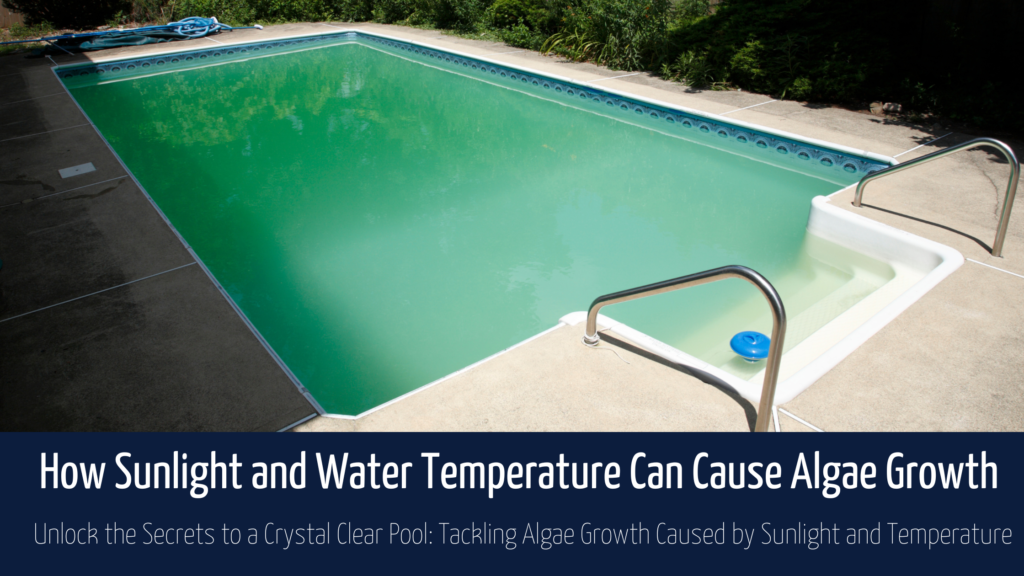
Stay tuned as we dive into the factors contributing to algae growth, such as sunlight and water temperatures, and learn how to prevent these pesky organisms from taking over your pool – even when it’s covered!
Understanding Algae Growth
Before tackling how to prevent algae growth in swimming pools, let’s first understand what algae are and why they can be such a nuisance for you.
Algae are microscopic, plant-like organisms that can thrive in water, especially when the conditions are just right. While they’re a natural part of our environment, when they start growing in our swimming pools, they can cause several problems.
For starters, algae can make the pool water look cloudy and uninviting. They can also create slippery surfaces on pool walls and floors, making it a safety hazard for swimmers.
Moreover, algae can also clog your pool’s filtration system, reducing efficiency and potentially costly repairs.
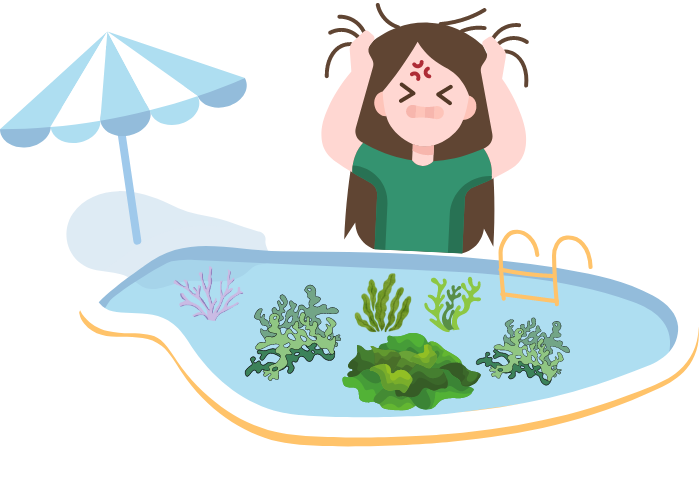
Now that we know why algae are problematic, let’s talk about the different types of algae commonly found in swimming pools:
Green Algae: The most common type of algae, green algae can quickly multiply and turn your pool water green. It can be free-floating or cling to surfaces and is often the result of improper water balance or lack of sanitization.
Black Algae: This algae is more stubborn and challenging to remove. Black algae form dark, protective layers that make them resistant to regular sanitizers. It typically appears as small black or dark blue-green spots on pool surfaces.
Yellow or Mustard Algae: As the name suggests, this algae type is yellowish and usually grows on the pool’s shaded areas, such as steps or behind ladders. Yellow algae can be challenging to eradicate because it’s more chlorine-resistant than green algae.
Pink Algae: While not a true algae, “pink algae” is a type of bacteria that can form slimy pink or red-colored layers on pool surfaces. It can be particularly pesky since it’s resistant to most sanitizers.
So, now that we have a better understanding of what algae are and the various types that can affect our swimming pools, let’s dive into how sunlight and water temperatures can contribute to their growth and explore ways to keep our pools algae-free.
The Role of Sunlight in Algae Growth
Let’s shed some light on how the sun plays a part in algae growth. As we know, sunlight is essential for life, including algae. These small organisms use the energy from the sun to carry out photosynthesis, a process that allows them to grow and reproduce.
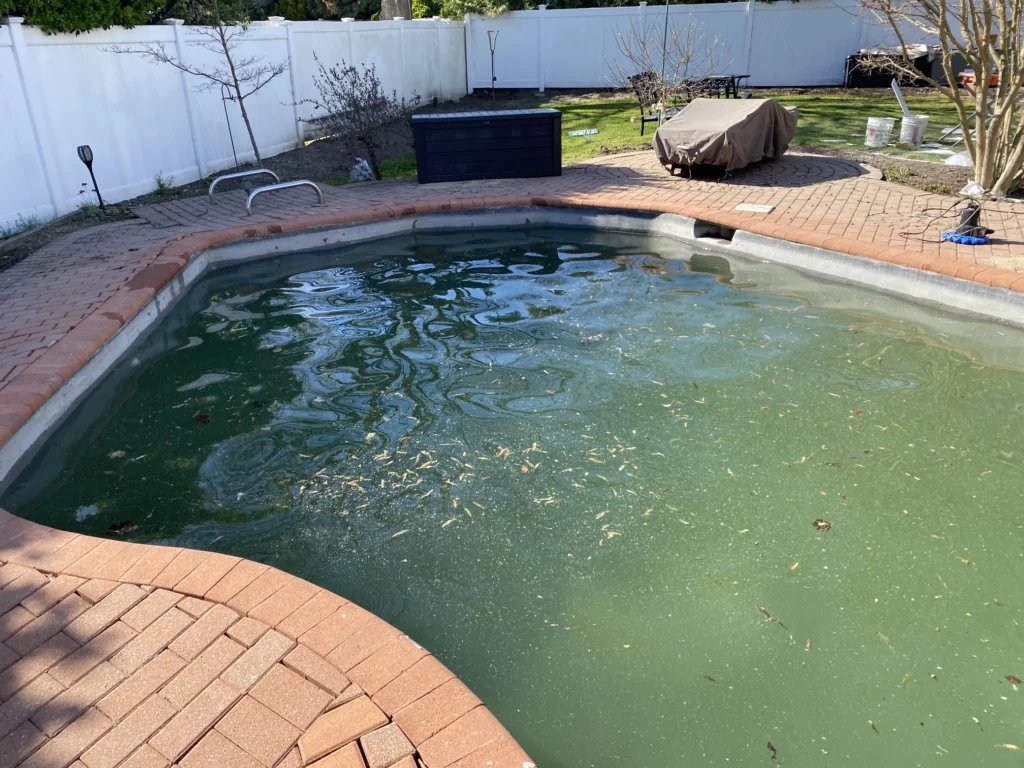
There are two ways that sunlight can impact algae growth in our pools: direct and indirect sunlight.
Direct sunlight is pretty straightforward – when the sun’s rays hit the pool water directly. On the other hand, indirect sunlight occurs when the sun’s rays bounce off nearby surfaces, such as trees or buildings, and reach your pool. Even when the pool is covered, some indirect sunlight might still find its way through, providing enough energy for algae to grow.
So, what can we do to minimize sun exposure and prevent algae growth in our pools? One of the most effective solutions is using a UV-resistant pool cover.
Here are some tips on choosing and using a pool cover that can help keep algae at bay:
- UV-Resistant Cover: When shopping for a pool cover, Look for one made with UV-resistant materials (reach out to us about having us install an Aqua Xtreme safety cover). This will help reduce the amount of sunlight that penetrates the cover and prolong the cover’s lifespan.
- Ensure a proper fit: A well-fitting pool cover is necessary to minimize the amount of sunlight entering your pool. Make sure to choose a cover that fits snugly around the edges of your pool to keep sunlight out as much as possible.
- Keep the cover clean: Over time, dirt and debris can accumulate on your pool cover, creating small gaps that allow sunlight to sneak through. Regularly cleaning your pool cover can help prevent this issue and ensure it remains an effective barrier against sunlight.
The Impact of Water Temperature on Algae Growth
We know that keeping our pools at a comfortable temperature is essential for enjoying a refreshing swim during the summer.
But did you know that water temperature can also significantly impact algae growth? That’s right, let’s learn how it affects these pesky organisms.
Warmer water temperatures can accelerate algae growth by providing an ideal environment for them to thrive.
Most algae species grow faster when the water temperature is between 77°F and 88°F. However, some algae types, like black algae, can tolerate temperatures as low as 60°F.
With our warm summers here in Long Island, keeping an eye on your pool’s water temperature is essential to prevent an algae bloom.
So, how can we maintain appropriate water temperatures and keep algae growth under control? Here are a few tips:
Monitor your pool’s water temperature: Regularly check your pool’s water temperature using a reliable thermometer. This will help you stay aware of any fluctuations that could lead to increased algae growth.
Take advantage of natural temperature regulation: If possible, take advantage of natural ways to regulate your pool’s temperature, such as shading it during the hottest part of the day or uncovering it during cooler evenings. This can help keep your pool’s water temperature within an acceptable range without additional equipment.
By keeping a close eye on your pool’s water temperature and maintaining it within the proper range, you can help prevent algae growth and ensure that your pool remains clean and enjoyable all summer.
Algae Growth in Covered Pools
Did you know that even when your pool is covered, algae can still find a way to grow? That’s right! A covered pool might seem like a foolproof way to keep algae at bay, but these microscopic organisms can be quite persistent.
Here’s a pool we recently opened in April that had a mesh cover on it – the sunlight got through, and algae bloomed!
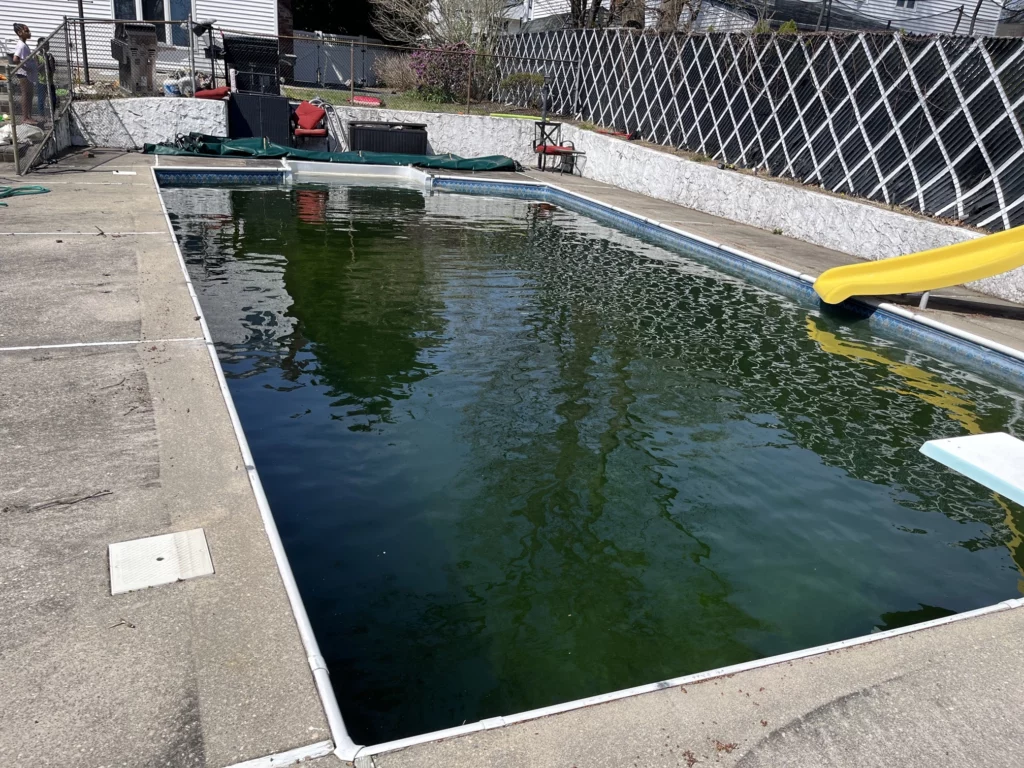
As mentioned earlier, indirect sunlight can still penetrate the pool cover and provide enough energy for algae to grow. This means that even when your pool is protected from direct sunlight, you must be proactive in preventing algae growth.
Here are some tips for keeping algae out of your covered pool:
Open the pool early: By opening your pool earlier in the season, you can ensure proper water circulation and filtration from the get-go. This helps prevent the buildup of nutrients that algae need to grow. Which makes it more difficult for them to take hold of your pool.
On top of that, opening earlier when the water is colder will allow the water chemistry to be balanced before the algae can begin growing.
Balance water chemistry: Maintaining balanced water chemistry is extremely important, whether your pool is covered or not. Regularly test your pool’s pH, chlorine, and other chemical levels to ensure they remain within the recommended range. This helps create an environment that is less conducive to algae growth.
You can subscribe to our full-season pool maintenance plan to let us worry about the technicalities while you focus more on enjoying your pool.
Clean your pool cover: Regularly inspect and clean your pool cover, as debris and organic matter can accumulate on its surface. This can create small gaps that allow sunlight to sneak through, providing enough light for algae to grow.
By following these tips, especially opening your pool early and maintaining balanced water chemistry, you can keep your pool algae-free and ready for fun all season long.
Opening the Pool Earlier to Prevent Algae Growth
Let’s talk about opening your pools earlier in the season and how it can be a game-changer in preventing algae growth. The earlier you get your pool up and running, the better equipped you’ll be to keep algae at bay throughout the summer.
Here are some fantastic benefits of opening your pool early that can help keep algae in check:
Allowing sunlight to naturally inhibit algae growth: Sunlight is a powerful natural algaecide. Opening your pool earlier in the season gives the sun a better chance to work its magic. Direct sunlight helps inhibit algae growth, keeping your pool water crystal clear and inviting.
Ensuring proper water circulation and filtration: A well-functioning circulation and filtration system helps significantly in preventing algae growth. By opening your pool early, you can get your pump and filter running sooner, making your pool water continually moving and the debris removed before algae can thrive.
Providing more time for pool owners to address and correct any chemistry imbalances: Maintaining proper water chemistry is critical to preventing algae growth. Opening your pool early gives you extra time to test your pool water, adjust chemical levels, and address any imbalances before they can lead to algae blooms.
So, consider opening your pool earlier this season.
Not only will it give you more time to enjoy the refreshing water, but it will also help ensure that your pool remains algae-free and sparkling clean all summer long.
Importance of Proper Pool Maintenance
Let’s take a moment to emphasize the importance of regular pool maintenance in keeping algae growth under control.
A well-maintained pool looks and feels great and ensures a healthy swimming environment for you and your loved ones.
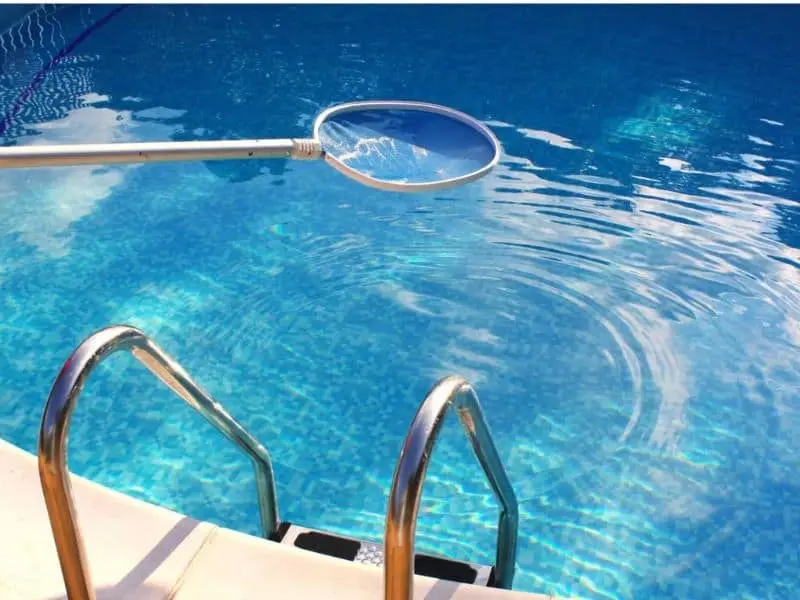
One of the critical factors in preventing algae growth is maintaining the proper water chemistry. Balancing your pool’s pH and chlorine levels is crucial to keep algae at bay and your pool water sparkling clean.
Proper circulation and filtration also play a vital role in preventing algae growth. By maintaining a well-functioning circulation system and keeping your filter clean, you can ensure that your pool water stays clear and free of contaminants that could fuel algae growth.
How can we implement all this knowledge for a successful early pool opening and maintenance routine?
Here are some practical tips:
Start regular pool maintenance routines earlier in the season: Get a head start on your pool maintenance by beginning your routine earlier in the season. This includes testing and adjusting water chemistry, cleaning the pool surfaces, and checking the circulation and filtration systems to ensure they’re in good working order.
Consult a pool professional: If you’re unsure about the best practices for early pool opening and maintenance, don’t hesitate to consult a pool professional like Romanelli & Son Pool Service. We can provide valuable advice and assistance to ensure a smooth and efficient pool opening process, setting you up for a fantastic summer of swimming and relaxation.
By following these tips and committing to regular pool maintenance, you’ll be well on your way to keeping algae growth at bay and enjoying a beautiful, clean, and refreshing pool all season long.
We understand that maintaining your pool can sometimes feel overwhelming or time-consuming. That’s why we offer our comprehensive full-season pool maintenance service, designed to keep your pool in tip-top condition all season long while taking the stress out of pool care.
Our experienced pool professionals will handle everything from a perfect pool opening, proper weekly pool maintenance that includes balancing water chemistry to ensure adequate circulation and filtration, to a peaceful pool closing to ensure your pool stays ready for the next season.
Trust us to provide the highest quality pool maintenance service and peace of mind, so you can sit back, relax, and enjoy your beautiful, algae-free pool all summer.
[Book full season pool maintenance] Button with full season page link
Additional Prevention Strategies
In addition to regular cleaning and maintenance, there are several additional prevention strategies that you can employ to keep algae at bay.

Here’s some advice to help you keep your pool in pristine condition:
Algae Fighting Pool Chemicals
Using algaecides, phosphate removers, or other specialized pool chemicals can effectively prevent algae growth. These products work by targeting and eliminating the microscopic organisms responsible for algae blooms. Adding these chemicals to your regular pool maintenance routine lets you keep your pool water sparkling clear and free of unwanted green, yellow, or black algae.
The Power of Phosphate Removers
Phosphates are a primary food source for algae, so removing them from your pool can help prevent algae growth. Phosphate removers work by binding to phosphates in the water, making it easier to filter them out. Regularly using a phosphate remover can starve algae of the nutrients they need to thrive, ensuring your pool remains clean and clear.
Opening Your Pool Earlier
We can’t stress enough the importance of opening your pool earlier. The longer a pool sits stagnant, the more organic debris and algae spores accumulate. Our climate can be unpredictable at times, but opening your pool earlier in the season is a smart move.
By opening your pool before the temperatures rise and the sun’s rays become more intense, you’ll have a chance to remove organic debris and algae spores that have settled over the winter months. This pre-emptive action can save you time, effort, and expense in the long run by preventing algae growth before it starts.
Final Words
Keeping your swimming pool algae-free and enjoyable all season long is essential. By understanding the effects of sunlight and water temperature on algae growth, we can take proactive measures to prevent these pesky invaders from taking over our pools.
By opening your pool earlier and balancing water chemistry, you’ll have a head start in preventing algae growth and maintaining a clean & safe swimming environment.
Don’t let algae get the best of you and your pool – take advantage of these tips and enjoy a sparkling clean pool all summer. With a little extra effort and the right strategies in place, you can spend more time enjoying your pool and less time battling algae.



